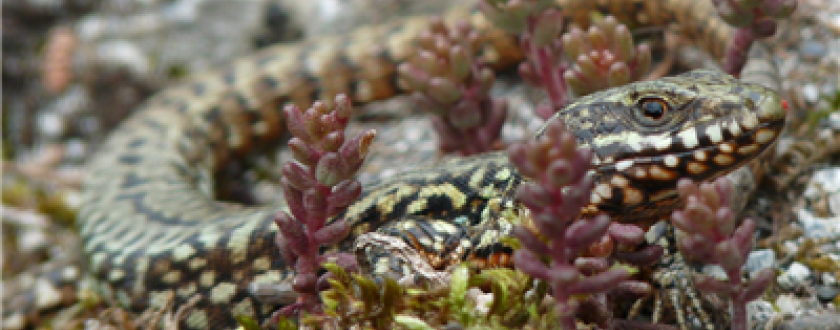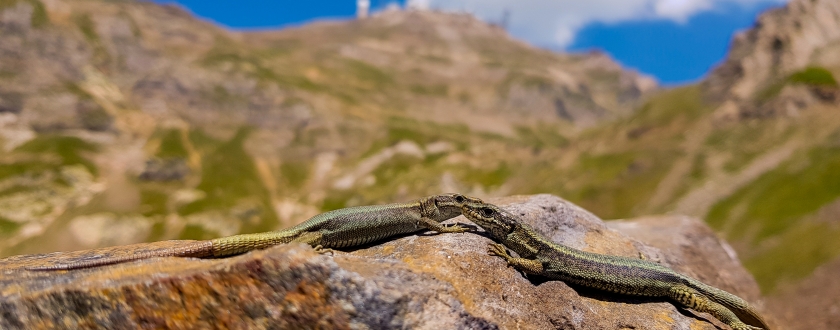Protecting three endemic and endangered Pyrenean lizards: Iberolacerta
Description of the case study
The current acceleration of climate change is having a particularly pronounced effect on the Pyrenean mountain range, causing altitudinal displacement of climate stages to which flora and fauna must adapt. This project studies the effects of climate change on the ecology of endemic and endangered lizards of the Pyrenean peaks (Iberolacerta bonnali, I. Aurelioi, and I. aranica). Apart from increased extreme and average temperatures, this alpine lizard has also been subjected recently to interspecific competition from the common wall lizard (Podarcis muralis) of the plains colonising the mountain environment. This lizard is climbing up to higher altitudes as a result of climate change, and is observed with increasing regularity between 1600 and 2200 metres, an altitude that puts them in contact with three Iberolacerta species. Competition for food, territory, and nesting locations cannot be avoided.
The study will help us understand how and to what extent these lizards are adapted and restricted to their high-altitude environments (low availability of oxygen in the air and relative cold), particularly in the context of global warming. This will force these animals to (1) climb up to the peaks, (2) suffer from increased temperature and, finally, (3) face a colonising, thermophilic species, and potential competitor: the Podarcis muralis common wall lizard.
Understanding this dynamic helps us apply efficient conservation measures: relocating populations, limiting new construction in sensitive locations, and providing construction materials for common wall lizards.
The aim of this project is to (1) continue to collect presence/absence data on each species across the altitudinal transects, and (2) measuring the combined effects of altitude hypoxia and temperature on the physiology of lizards and their eggs in a warm climate.
The common wall lizard is an opportunistic, thermophilic, and circummediterranean species that is moving to higher altitudes as the climate warms. It is commonly observed above 1500 metres, and occasionally at up to 2000 metres, where it comes into contact with Pyrenean lizard populations. Locally, the increased altitude of the Podarcis muralis is rapid, with an associated decrease in the number of local Iberolacerta (Matthieu Berroneau, personal communication). However, research has shown the harmful effects of altitude hypoxia on the embryo, young, and adult wall lizards, which could probably slow altitudinal colonisation slightly.
Lastly, it seems that Pyrenean lizards are at a disadvantage at lower altitudes (greater availability of oxygen), which could limit population management prospects in other locations.
The case has been developed and applied mainly through the goals of other policies not relating to adaptation, but ones that take into account climate change adaptation aspects.
CNRS SETE in Moulis, OMP (Observatoire Midi-Pyrénées) Pic du Midi.
Additional Information
The partners that have historically participated in this project are Nature en Occitanie, Bomosa (Andorra), CRARC (Spain), Cistude Nature, CNRS SETE in Moulis, CNRS MARBEC in Sète, OMP Pic du midi.
All of which working on the continued presence/absence sampling in the massif. Two organisations, CNRS and the CRARC, are carrying out scientific experiments and analyses.
This study is complex to execute due to the nature of the terrain and the few meteorological windows that allow for high-mountain sampling and capture.
On the other hand, the scientific community is highly receptive to these current themes, which facilitates information being spread quickly.
In the same way, awareness-raising on the problem of endemic Pyrenean lizards being endangered due to climate change among school children and mountain users (hikers in particular) is high, and communication in schools or through the Pic du Midi is highly efficient at raising public awareness.
Promotional film
Financing for this study mainly came from a 185,076 euro Marie-Curie Sklodowska research grant, which produced 24 months of salary for a post-doctorate intern (Eric Gangloff).
This project is part of the open call H2020-MSCA-IF-2016 (individual Marie Skłodowska-Curie grants).
06/01/2017 - 12/01/2022 (5 years - in progress)
Reference information
PYRENEAN CLIMATE CHANGE OBSERVATORY
Avenida Nuestra Señora de la Victoria, 8
22.700 - Jaca
Huesca - España
+34 974 36 31 00
info_opcc@ctp.org






